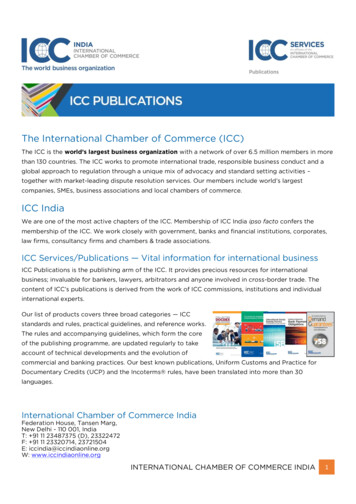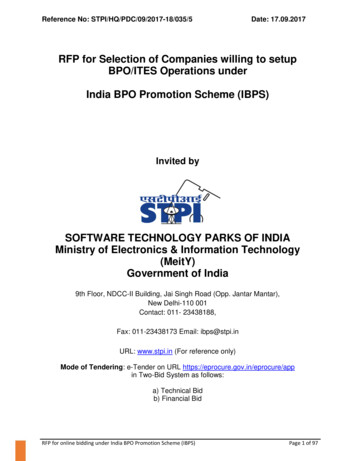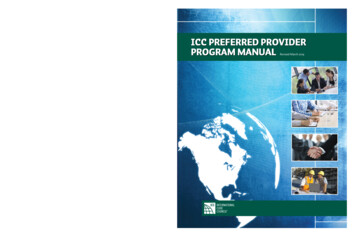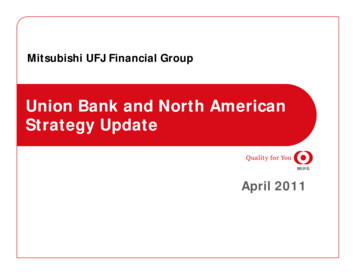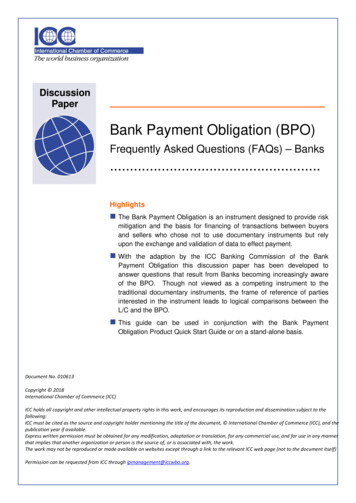
Transcription
DiscussionPaperBank Payment Obligation (BPO)Frequently Asked Questions (FAQs) – Banks.Highlights The Bank Payment Obligation is an instrument designed to provide riskmitigation and the basis for financing of transactions between buyersand sellers who chose not to use documentary instruments but relyupon the exchange and validation of data to effect payment. Withthe adaption by the ICC Banking Commission of the BankPayment Obligation this discussion paper has been developed toanswer questions that result from Banks becoming increasingly awareof the BPO. Though not viewed as a competing instrument to thetraditional documentary instruments, the frame of reference of partiesinterested in the instrument leads to logical comparisons between theL/C and the BPO. Thisguide can be used in conjunction with the Bank PaymentObligation Product Quick Start Guide or on a stand-alone basis.Document No. 010613Copyright 2018International Chamber of Commerce (ICC)ICC holds all copyright and other intellectual property rights in this work, and encourages its reproduction and dissemination subject to thefollowing:ICC must be cited as the source and copyright holder mentioning the title of the document, International Chamber of Commerce (ICC), and thepublication year if available.Express written permission must be obtained for any modification, adaptation or translation, for any commercial use, and for use in any mannerthat implies that another organization or person is the source of, or is associated with, the work.The work may not be reproduced or made available on websites except through a link to the relevant ICC web page (not to the document itself)Permission can be requested from ICC through ipmanagement@iccwbo.org.
Frequently Asked Questions – BanksTable of ContentsI.Getting Started with BPO . 3II.About BPO . 4III.BPO Governing Standards: The URBPO. 5IV.Bank Payment Obligation (BPO) vs. Letters of Credit (LCs) and Open Account Trade 7V.Data vs. Documents, Goods, Services, or Performance . 9VI.Accounting & Capital Treatment . 11Document number – page 2
Frequently Asked Questions – BanksI. Getting Started with BPOIf a bank is interested in becoming a participant member immediately for BPO (Bank PaymentObligations), how do we go forward?A bank will first register with the SWIFT Trade Services Utility (TSU). The bank can register on-line viawww.swift.com.The registration fee varies according to the global tier of the bank. Once registered,SWIFT will assist the bank to go live. For further information please email SWIFT atsupplychain@swift.com. With ICC approval of URBPO, other services providing Transaction MatchingApplications, similar to the TSU, are eligible to support BPO transactions.What are the requirements for a bank to implement BPOfrom an operational perspective?The BPO offers a new instrument to support trade settlement. As a result, the implementation of BPOis a business paradigm shift from paper-handling to electronic processing that impacts sales, legal,accounting, credit management, risk management, and operations. It will require a change in theexisting processes as well as in the underlying IT infrastructure.Initially, in a low volume environment, a bank can take a low technology approach using a web-basedaccess to the Trade Services Utility to data enter the information necessary to build a baseline basedupon their customer’s traditional approach to applying for a transaction. With the submission ofdocuments, a similar data entry approach can be taken to enter the data sets necessary to respondthe baseline. This facilitates the bank becoming more familiar with the translation of traditional tradetransactions into a data driven business process.As transaction volumes increase and customers become more willing to exchange data, banks mayneed to update their trade portals to support the BPO flow and to offer reporting and tracking services,similar to the services provided for L/Cs and guarantees. Back-office applications also need to beadjusted and preferably connected to the TMA interface. To complete the digital communicationbetween the corporate and SWIFT TSU, it is also beneficial implement a BPO Frontend to allow fordirect digital communication between TMA and the bank. These costs are offset by anticipatedsavings in operating costs with the elimination of document examination and related manual processsteps associated with these types of transactions.Is it necessary to have an agreement between banks?All banks participating in a BPO transaction must be subject to the URBPO and in so doing accept theterms set out in the rules. The establishment of a baseline represents the agreement between banksfor any given transaction. There is no need for bilateral agreements to be negotiated separatelybetween banks. Under the URBPO banks who subscribe to the rules are governed by them as is thecase under UCP or other ICC publications. In addition, if the banks choose the TSU as their TMA, thebank will be subject to the SWIFT TSU Rulebook.What are the operational savings one could expect from enrolling in the TSU or similarTransaction Matching Application?Operational savings will include first a reduction in the expense of document examination. Secondly,there will be a reduction in the number of discrepancies thanks to an improvement in the matching ratethat can be achieved by electronic data presentation. By reducing the number of discrepancies, banksand corporates will be able to reduce the investigation effort, avoiding disputes, delays etc. The impactwill vary from business to business.Assuming that a customer of my bank wants to join BPO settlement who can find acounterparty willing to work on BPO settlement?Document number – page 3
Frequently Asked Questions – BanksOver time, all trade banks would need to adopt the BPO. Today, more than 100 banks are registeredto the TSU to support BPO transactions. Please email SWIFT at supplychain@swift.com to receive anupdated list ofBPO-available banks.II. About BPOWhat message types and data are supported in BPO?A set of ISO 20022 messages has been developed for the BPO. The relevant ISO 20022 tsmtmessaging standards and related documentation are available on the ISO20022 website(www.iso20022.org), page “Catalogue of ISO 20022 messages” tsmt.001-052. The data elements,which are part of a Transaction Matching Application (TMA) transaction, represent extracts from thefollowing document types: purchase order, commercial invoice, transport and insurance documents(optional), and certificates (optional).Does the BPO work with the MT798?No, the MT798 standards offer multi-banking standards for L/Cs and Guarantees; the ISO 20022standards support the BPO. Both MT798 and ISO20022 standards work in parallel achieving differentobjectives.In order to keep industry terminology consistent, instead of referring to a “silent confirmation”,would it not make more sense to call them “silent obligation” or “silent undertaking”?The concept of “adding a confirmation”, i.e. the Recipient Bank of the BPO adding their undertaking topay upon presentation of a compliant data set in favour of the exporter, is part of each bank’s ownvalue proposition. A common terminology has thus not been defined for this concept and will be left foreach bank to decide. The reason that the industry keeps referring to “silent confirmation” is merelybecause the market is familiar with the concept of a silent confirmation in the documentary Tradeworld. As to whether “silent obligation” or “silent undertaking” would be a better term, it completelydepends on the bank’s value proposition and what agreement has been signed with the exporter.The term “acceptance” is increasingly used in combination with BPO examples. Given that thedefinition of the BPO is an “independent undertaking of an Obligor Bank to pay or incur adeferred payment obligation”, can the BPO be available by acceptance at all?The word “acceptance” in this sense does not refer to the same concept we are familiar with in thedocumentary Trade world, i.e. the acceptance of a bill of exchange. The BPO is based aroundpresentation of data – the equivalent to an acceptance in the L/C world would be a clean data matchreport generated by the TMA or an acceptance message generated by the Obligor bank in case adata-mismatch has been accepted. In the BPO world the “acceptance” is more for negotiationpurposes.How is the BPO related to Supply Chain Finance?According to the new Standard Definitions for Techniques of Supply Chain Finance, published on 9March 2016, the BPO is not seen as a SCF technique itself, but as an enabling framework for SupplyChain Finance.The BPO offers opportunities for the discounting of receivables due under a BPO based on the risk ofthe Obligor Bank:Document number – page 4
Frequently Asked Questions – Banksa) Post-shipment finance: Discounting of the deferred payment after successful matching of trade dataandb) Pre-shipment Finance: Based on a BPO transaction after establishment of the Baseline.Especially for open account trade flows, the BPO offers new possibilities for finance in addition to itsrole as payment instrument to secure paymentsIs the BPO an effort to make SCF better internationally regulated?No – the new Standard Definitions for Techniques of Supply Chain Finance, published on 9 March2016 support in international regulation of SCF. According to these definitions, the BPO is an enablingframework for SCF.Under the BPO scenario, presumably banks expect to charge fees to their customers?Yes. The banks will set their own tariffs when charging the corporate customer. Those charges willvary from bank to bank.Fees charged by the Obligor Bank to the Buyer would typically reflect the transaction processing andhandling costs of managing data input/ exchange with the Transaction Matching Application (TMA) aswell as a risk premium for the buyer based upon the Buyer’s credit rating.On the other hand, the Recipient Bank (Seller Bank) would charge the Seller fees for transactionprocessing and handling costs for managing the data input/ exchange with the TMA and possibly, arisk premium associated with the credit worthiness of the Obligor Bank if the Recipient Bank is offeringan additional payment undertaking to the Seller (analogous to a silent confirmation of an L/C).Can a multilateral or an ECA act as an Obligor bank?In order to issue a BPO the Obligor will need to issue the instrument using an ISO 20022 compliantTransaction Matching Application, such as the TSU. SWIFT can provide you with updated informationon who can get access to the TSU. Though ECAs at this time are not directly engaged in the BPOprocess, most are adjusting their agreements to support BPOs in addition to the traditionaldocumentary means.III. BPO Governing Standards: The URBPOIs there an internationally accepted standard for the BPO e.g. similar to UCP 600? Does thelegal enforceability of the concept need to be checked in each jurisdiction?The ICC has published rules governing the BPO, the Uniform Rules for Bank Payment ObligationsPublication 750 which are expected to have the same effect as UCP 600 has for L/Cs. The URBPOprovides the legal basis for handling BPO between involved banks.Unless otherwise specified in the BPO the governing law and jurisdiction will be that of the ObligorBank.How does the ICC support market adoption of the BPO?The ICC Banking Commission has developed rules which recognize the Bank Payment Obligation asan accepted market practice in much the same way as the L/C has become an accepted marketpractice with the support of UCP. The BPO market adoption is supported by the publication of theDocument number – page 5
Frequently Asked Questions – BanksUniform Rules for Bank Payment Obligations (URBPO), a set of rules governing the handling of BPObetween involved banks. The ICC has recently agreed to revise the URBPO to be better aligned withmarket needs and to allow for better market adoption.In addition to the URBPO, SWIFT has also issued a TSU Rule Book for operating the SWIFT TSUPlatform.What is the status of the ICC rules for the BPO?The ICC Banking Commission has approved the Uniform Rules for Bank Payment Obligation (URBPO750) at the Banking Commission meeting of April 2013. The URBPO was officially launched mid-Maywith effect as of July 1, 2013. These rules are technology-independent. The only material changes thatneed to be made relate to the availability of the BPO through alternative technology platforms i.e. decoupling the BPO from the mandatory use of the TSU.The ICC has recently agreed to revise theURBPO to be better aligned with market needs and to allow for better market adoption.Does the Seller’s Bank have an obligation to pay, or only the Buyer’s Bank?Under a BPO, the Obligor Bank (which is normally also the Buyer Bank) undertakes an obligation topay the BPO Recipient Bank (which is always the Sellers Bank). The obligation of the Seller’s Bank topay the seller is outside the direct scope of the BPO and may be covered separately in the relatedagreement between the bank and the customer.If the Buyer’s Bank goes bankrupt, would the Seller’s Bank be obligated to pay?The only obligation arising from a BPO is that of the BPO Obligor Bank to pay the BPO RecipientBank. The Seller's Bank (Recipient Bank) is under no obligation to pay the seller under URBPO. If abaseline has been successfully established between the Buyers Bank and the Recipient Bank (SellersBank) and the payment has yet to be effected (deferred payment BPO) then in the case of bankruptcyof the Buyer Bank (Obligor Bank) the Recipient Bank may agree outside of the URBPO to pay as ithas accepted the risk of the Obligor Bank.If the Buyer’s Bank does not perform in a timely manner or goes bankrupt, is there anobligation on the part of the Seller’s Bank to pay the seller?No. The URBPO relates only to the obligation of the Obligor Bank (often but not always the BuyerBank) to pay the BPO Recipient Bank (always the Seller Bank)—the Seller Bank is under no obligationto pay the Seller under the URBPO unless the Seller Bank offered an additional undertaking to payunder a separate contractual agreement between them and the Seller (analogous to a silentconfirmation of an L/C).If the buyer does not pay, who is responsible to pay the seller? Obligor Bank or RecipientBank?The only obligation arising from a BPO is that of the BPO Obligor Bank (Buyer Bank) to pay the BPORecipient Bank (Seller Bank). The obligation of the BPO Recipient Bank to pay the seller as ultimatebeneficiary will be covered in the underlying agreement between bank and customer.Is there any guideline for silent confirmation on the BPO?There are no guidelines – the relationship between the seller and the Recipient Bank (as thebeneficiary of the BPO) has not been defined as part of the URBPO and thus been left in theDocument number – page 6
Frequently Asked Questions – Bankscompetitive space of each bank. Banks will determine their own BPO value propositions and thecorresponding legal framework and contract with the counterparty (the seller).IV. Bank Payment Obligation (BPO) vs. Letters of Credit (LCs) andOpen Account TradeWhat is the difference between an L/C and a BPO?An L/C requires physical presentation of documents through the banking system. Under a BPO thosephysical documents will be sent directly from seller to buyer, as in an open account transaction.However, selected elements of data which have been extracted from the documents will be routedthrough the banking system for the purposes of automated matching to mitigate risk and to support thevalue proposition for a financial service e.g. pre-or post-shipment financing.Another difference between an L/C and a BPO is the beneficiary of the payment undertaking. Under aBPO, the Obligor Bank (Buyer Bank) provides an irrevocable payment undertaking to the RecipientBank (Seller Bank). Under an L/C, the beneficiary is the Seller.What is the risk differential between BPO &L/C?The BPO is an inter-bank instrument used to mitigate the payment risk of a trade transaction. Similarto an L/C, a BPO is an irrevocable payment undertaking provided by the Buyer Bank (Obligor Bank) tothe Seller Bank (Recipient Bank) to pay a specified amount on maturity. As an interbank instrument,any risk mitigation by the Recipient Bank in favour of the Seller is separate from the BPO and can beforwarded on the basis of a separate legal contract.The BPO thus enables a bank (Obligor Bank or Recipient Bank) to provide risk mitigation in thecontext of an open account and supply chain financing solution. Both the L/C and the BPO can;therefore: a) act as a means of mitigating risk; b) provide the exporter assurance of payment; c) act asa form of collateral for financing.Unlike an L/C, the BPO does not require trade documents to be presented and routed through thebanks, it is based on the electronic submission and matching of data; trade documents are sentdirectly sent by the Seller to the Buyer without the involvement of the banks. As an enablingframework for supply chain finance (see Global Definition of SCF), the BPO offers numerous financingopportunities along the physical supply chain.Why is the BPO marketed as a different product and not treated as a further development of theLetter of Credit?Whereas the L/C is part of a traditional documentary Trade proposition, the BPO would be as part ofbank-assisted Open Account trade and thus be somewhere between documentary Trade and OpenAccount. The L/C is based on paper documentation whereas the BPO relies on the presentation ofdata sets. The aim of the BPO is to enrich the portfolio for banks and to enable banks to provide moreoptions for risk mitigation and financing in the open account space. The BPO proposition wastherefore developed based on limitations with existing bank offerings in that space. There is no reasonthat the BPO and L/C cannot co-exist. The BPO takes over the best practice of the L/Cs but providesthe banks with full visibility on the transactions.It also takes over the best practices of Open Account since the original documents are exchangedbetween the buyer and the seller. The BPO allows the banks to extend Supply Chain Finance servicesand make them based on international standards. With BPO, banks can be involved at the right stage,Document number – page 7
Frequently Asked Questions – Banksstarting with the purchase order and can finance the invoice before the approval of the invoice. TheBPO is there to extend Supply Chain Finance practices and provide opportunities in the 4-cornermodel (corporate-bank-bank-corporate) instead of the 3-corner model (corporate-bank-corporate).How will BPO fees compare to L/C fees?Each bank will set its own tariff and charges will thus vary from bank to bank. One would expect thatthe use of a Transaction Matching Application would reduce the transaction processing costscompared to L/C fees. Risk fees are expected to be at the same rate as for an L/C but may becharged for a shorter period as a BPO can be added at any point in the trade cycle, so exposureduration is likely to be shorter than with an L/C.Could BPOs be provided which act in a way similar to Standby L/Cs?No. BPOs are meant to be paid at maturity upon successful matching of data related to an underlyingtrade transaction between a buyer and a seller. In this respect, BPOs are similar in nature tocommercial letters of credit—not standby L/Cs.Letters of Credit are known to be subject to high costs. Will BPO help in lowering these costs?Because BPO is based on digital flows, banks charge lower fees for the settlement of transactions.The data matching is carried out electronically on the SWIFT TSU platform; hence, the manualworkload, e.g. for checking documents decreases. Furthermore, corporates benefit from the digitaldata flow for the benefit of faster, optimised and cheaper processes. The focus is clearly onincreasing efficiencies: suppliers will get paid faster and all parties benefit from the bank-to-bankefficiencies.In the documentary credit world, lately a so-called synthetic L/C becomes increasinglyimportant with regards to facilitating financing (rather than facilitating a trade settlement). So isthere any tendency to make BPO synthetic as well?The concept of the BPO is still in its infancy and there is no concept of using a more syntheticstructure at this stage. All BPOs have to be related to underlying transactions. The banks can thenoffer financing solutions for the exporter or importer based on the BPO.What is the difference between a BPO and a L/C using eUCP? How can transport documentslike a bill of lading be handled under BPO?The letter of credit and the BPO represent two alternative methods of payment. Where a letter of creditallows the presentation of electronic records the related terms of payment will be governed by eUCPas a supplement to UCP. If a BPO is used, the related terms of payment will be governed by theURBPO. In this case, the proposition is enhanced by the automated matching of data. Transportdocuments like bills of lading will provide a source of such data to populate the fields that are includedin the transport data set. The information in the transport data set is matched against information inthe baseline and other data sets. In this case, the transport (routing) information in the transport dataset is matched against the corresponding transport (routing) information in the baseline. Physicaldocuments (e.g. bill of lading) are directly sent by the seller to the buyer outside of the bankingchannels unless otherwise agreed by the parties.Similar to the L/C, is it possible to have a BPO “confirmed?Document number – page 8
Frequently Asked Questions – BanksThe BPO is a bank-to-bank obligation. As such a BPO Recipient Bank may be taking on the risk thatthe BPO Obligor Bank does not pay. Since the BPO is bank-to-bank only the BPO cannot be“confirmed” in the same way as an L/C can be confirmed; however, the Seller may separately agreewith his bank for an additional undertaking (“silent confirmation”).Can a BPO be transferred or assigned like L/Cs? Is there such a thing as a transferable BPO,as in L/C?No. A BPO is a bank-to-bank obligation. As such, payment will be made from a BPO Obligor Bank(often also the Buyer’s Bank) to a BPO Recipient Bank (Seller’s Bank). The beneficiary of a BPO willalways be the Seller’s Bank not the seller so transferability is not an option. The seller may instruct theBPO Recipient Bank separately to execute payment in favour of a third party assignee who may havebeen responsible for the actual delivery of goodsWhy should a Buyer move from Open Account to BPO when the former is much cheaper?There are various benefits for a Buyer moving to BPO from open account settlement: Financing opportunities: In case the Seller has liquidity problems, the Buyer can offerfinancing for the deferred payment period of the invoice. In the event that the Buyer wants tooptimise his working capital by extending his payment terms, he can also offer financing to theSeller to prevent liquidity problems on the Seller’s side. Increased supply chain transparency: With the near-term provision of data regarding thepurchase order, invoice, shipment, and other data, the buyer benefits from an increasedtransparency in his supply chain. Faster processing: The exchange and matching of data on SWIFT TSU enables fasterprocessing of the trade transaction.V. Data vs. Documents, Goods, Services, or PerformanceAre there limitations to the data fields in the baselines supporting BPO? Of concern is theavailability of data for compliance screening.There is an incorrect perception in the market that BPO baselinemessages are always very complex.While the number of mandatory fields to complete a BPO is very limited, optional data fields such asthose related to transport or insurance may be added.This does not prevent banks from requesting additional data and information from their clients to beable to conduct the necessary checks (e.g. compliance and sanctions checks).Does the Recipient Bank need to conserve a paper copy of commercial invoice or other docs ?In its strict definition, the URBPO does not require the banks to keep any paper documentation at all.Each bank will have to make a decision as to whether a paper record might be required for reasonssuch as audit, sanctions etc.How would a BPO prevent a fraudulent shipment?The BPO does not by itself prevent fraud. Of course, banks will be required to carry out their standardKYC & due diligence checks for their customers, together with compliance checks based on the datathey have received, before engaging in any BPO transaction. However, the banks submitting the dataare not required to validate the data that they submit to the TMA, but are only expected to ensure thatthe data they received from their customer is the same as the data that was submitted.Document number – page 9
Frequently Asked Questions – BanksHow would the BPO handle the sanctions clauses that are so common in L/Cs nowadays?Sanctions screening must be performed on all BPO transactions as required under local, internationaland European regulations, even when there is no sanction clause in the instrument. This is outside thedirect scope of the TMA and should form part of the banks’ standard operating procedures. All partiesto a BPO transaction will have access to the same level of information for screening purposes.Furthermore, each bank should take a view as to how it wants to behave towards sanctions clauses inits contracts with its counterparties.eUCP was developed to facilitate the exchange of electronic documents. Is there any intentionto integrate eUCP with the URBPO?The scope of the two sets of rules is different. The eUCP is a supplement to UCP designed toaccommodate the presentation of electronic documents (e.g. scanned images) under a letter of credit.The eUCP will continue to exist alongsideURBPO.The BPO is based on the successful matching of data and not directly related to any trade documents.Nevertheless, the data matching for the BPO being linked to eDocs , e.g. the eB/L, will help tradefinance to reach further steps in the digitisation process.An additional advantage of the BPO is that it is underpinned by ISO 20022 messaging standardsenabling fully automated data processingrather than the reliance upon documents in eitherconventional or electronic form.Will the BPO be a good alternative for documentary collections as well? If yes, what aboutphysical documents?Yes. The BPO would be more secure than a documentary collection since there would be anobligation to pay. A documentary collection may be regarded as a more secure alternative for theseller compared to trading on open account, but less secure than a L/C.Under a BPO, this obligation would be based upon the presentation of data through the bankingsystem rather than physical documents. The documents would be sent directly to the buyer.There is a risk that the supplier creates a data set that is different from the content of the actualdocuments. Will this not affect the uptake of the BPO?The integrity of both the buyer and seller/ supplier is obviously very important. The BPO aims atincreasing efficiency. This is only possible if there is a certain level of trust between the seller andbuyer as well as the respective banks. Each bank will follow their usual client selection, control andKYC processes and will have to ensure that the client will respect the contractual engagement andprovides data extracted from the original documents only. The BPO was not designed to supporttransactions between two corporates (and banks) dealing with each other for the first time.Is it possible to check for negative clauses (i.e. boycott clauses)?The TSU does not do negative clause checking. It is the responsibility of each of the participatingbanks to enforce any of the local compliance requirements outside of the TSU.Document number – page 10
Frequently Asked Questions – BanksVI. Accounting & Capital TreatmentWhat is the view of large accounting firms on the BPO treatment?The BPO Education Group has published a document on BPO Accounting & Balance Sheet treatmentto provide some guidelines. Banks who have been examining the BPO have been reviewing thecapital treatment or asset classification that and individual banks may have engaged accounting firmsbut there is not an official accounting industry opinion being developed to our understanding andawareness.Are the accounting and capital treatment that are talked about today being proved right?The treatment proposed in the white paper was endorsed by banks part of the Education Group, someof which are already active with the BPO. For the time being, we have had no contradictory opinionsreceived from other banks or regulators. Fortunately, we do not have any experience of losses anddefaults with BPOs.If the Recipient Bank does not add a confirmation what is the accounting treatment?The notion ‘confirmation’ in the frame of a BPO does not exist in the rules Recipient Banks, as part oftheir commercial offerings to their sellers may develop products similar to the documentaryterminology of “silent confirmation” or “silent obligation”. If a bank does not offer a silent obligation of aBPO to its customer, the accounting treatment is similar to that of a payment. The bank will simplytransfer the payment to the seller when it is received from th
on who can get access to the TSU. Though ECAs at this time are not directly engaged in the BPO process, most are adjusting their agreements to support BPOs in addition to the traditional documentary means. III. BPO Governing Standards: The URBPO Is there an internationally accepted standard for the BPO e.g. similar to UCP 600? Does the

